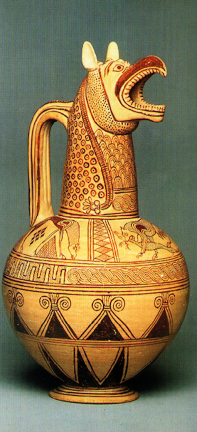
Cycladic Jug, Found on Aegina, an island in the Mediterranean
700-650 BCE
ART 198 - HISTORY OF WORLD CERAMICS
| This zoomorphic vessel shows the increasing skill of the potters of the Mediterranean during the Bronze Age. Wheel thrown from parts and assembled, this jug has a spout modeled in the form of a griffin's head with a ferocious beak serving as the pouring spout. Showing the influences both of pre-geometric Greek pottery and design elements of Middle Eastern pottery, this pot literally sits astride the trade routes of the Ancient Mediterranean. Zoomorphism refers to the use of motifs combined from different animals to create a never before seen creature, often representing a diety. A Griffin is a mythological, winged monster, with an eagle-like head and the body of a lion. Its precise meaning in mythology remains unknown, but originated in the Middle East around 2000 BCE. Finely thrown, burnished, and painted with an iron slip, the decoration shows a grazing horse in one panel, and a lion killing a stag in another. An early representation of the meander pattern is evident in the panel at mid left as well. Glazing was certainly known to potters of this time, but most chose to not use it, focusing instead on the art of slip painting, in which designs and colors are less likely to bleed. Pottery such as this is often referred to as Cycladic, from the Cyclades, the name given to the collection of islands between Greece and Asia Minor. This vessel was found on the island of Aegina. | Cycladic Jug, Found on Aegina, an island in the Mediterranean 700-650 BCE |
|
|